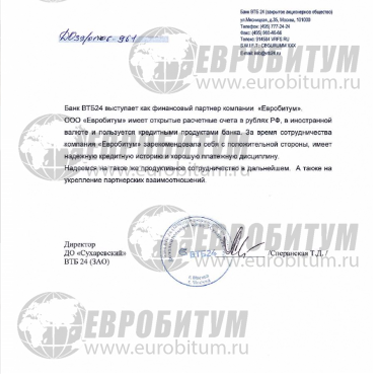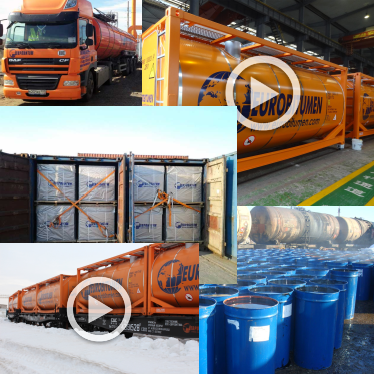Road oil bitumen
Road bitumens are mainly used for the construction and repair of road and air field coverings. Road oil bitumens are subdivided into the viscous and the liquid ones.Viscous road oil bitumens are made of oxidized and nonoxidized products of straight distillation of oil and compounding of oxidized and nonoxidized products obtained through straight distillation of oil and selective separation of oil products (deasphalting asphalts, extracts of selective purification and others). The production of viscous road bitumens out of cracked residues and deasphalting asphalts is not allowed without additional processing.
Viscous bitumens are distinguished as: BND (road oil bitumens) and BN (oil bitumens).
Viscous road oil bitumens are manufactured of five grades: BND 40/60, BND 60/90, BND 90/130, BND 130/200, BND 130/200; whereas oil bitumens (BN) - of four grades: BN 60/90, BN 90/130, BN 130/200, BN 200/300.
Letters BND stand [in Russian] for "road oil bitumen", fraction figures 40/60, 60/90 etc. indicate the limits of parameters of standard needle penetration depth at 25°С, acceptable for the grade, which is indirectly characteristic of the viscosity of bitumen. Grade BND bitumens are distinguished for good adhesion with stone materials and have high enough plasticity at sub-zero temperatures, are resistant to climatic impacts. Technical conditions for viscous oil bitumens are regulated by GOST 22245-90.
The viscous road oil bitumens are used to prepare the hot, warm and cold road asphalt-concrete mixes, for surface treatment, impregnation, and also for dilution for the purpose of obtaining liquid bitumens used to prepare cold asphalt-concrete, for surface treatment and for mixing on the road, etc.
The properties of road bitumen are determined by characteristics of its composition and structure. The main parameters of this material are the viscosity, plasticity and thermal resistance. These parameters are interconnected. As the oils content increases, the temperature and duration of exposure to loadings rises, the viscosity decreases and the plasticity increases. Resins determine binding properties of bitumens and tars, give them plasticity, increase adhesive capacity. Asphaltenes in bitumens and free carbon in tars raise the softening temperature and hardness.
Viscous bitumens are attributed to one or other grade on the basis of three basic parameters: depths of penetration of needle, softening temperature and extensibility. Depth of penetration of needle and extensibility are standardized at two temperatures: 25°С and 0°С.
Quality parameters of viscous road bitumens of grade BND
|
Parameter Designation |
BND 200/300 |
BND 130/200 |
BND 90/130 |
BND 60/90 |
BND 40/60 |
|
Needle penetration depth in bitumen, 0.1 mm: |
| ||||
|
at 25°С |
201-300 |
131-200 |
91-130 |
61-90 |
40-60 |
|
at 0°С |
45 |
35 |
28 |
20 |
13 |
|
Softening temperature by ring and sphere, °С, not less: |
35 |
39 |
43 |
47 |
51 |
|
Extensibility, cm, not less: |
| ||||
|
at 25°С |
- |
65 |
60 |
50 |
40 |
|
at 0°С |
20 |
6 |
4.2 |
3.5 |
- |
|
Brittleness temperature, °С, not more: |
-20 |
-18 |
-17 |
-15 |
-10 |
|
Flash temperature, °С, not less: |
200 |
220 |
220 |
220 |
220 |
|
Adhesion to marble or sand |
conforms to control sample No. 2 | ||||
|
Change of softening temperature after warming up, °С, not more: |
8 |
7 |
6 |
6 |
6 |
|
Penetration index: |
+1 |
- |
-1 |
-1 |
-1 |
|
Content of water-soluble compounds, %, not more: |
0.2 |
0.2 |
0.3 |
0.3 |
0.3 |
Bitumen BND 200/300 is used for surface treatment of coverings in cold climate areas, and also for the preparation of warm asphalt-bitumen and bitumen mineral crushed stone and gravel mixes.
Bitumen BND 130/200 is used for surface treatment of coverings in moderate climate areas, for impregnation of crushed stone coverings in cold and moderate climate areas, for the preparation of hot asphalt-bitumen and bitumen mineral mixes in cold climate areas.
Bitumen BND 60/90 is used to impregnate road crushed stone coverings in warm climate areas, for the preparation of hot asphalt-bitumen and bitumen mineral mixes in warm climate areas.
Bitumen BND 40/60 is used for the preparation of asphalt-bitumen and bitumen mineral mixes in areas with summer temperatures at > 30°C.
Quality parameters of grade BN viscous road bitumens
|
Parameter Designation |
BN
|
BN
|
BN 90/130 |
BN 60/90 |
|
Needle penetration depth in bitumen, 0.1 mm: |
| |||
|
at 25°С: |
201-300 |
131-200 |
91-130 |
61-90 |
|
at 0°С: |
- |
- |
- |
- |
|
Temperature, °С of: |
| |||
|
softening, not less |
33 |
37 |
40 |
45 |
|
same after warming up, not more: |
- |
- |
- |
- |
|
brittleness, not more: |
8 |
7 |
6 |
6 |
|
flash, not less: |
200 |
220 |
220 |
220 |
|
Extensibility, cm, not less: |
| |||
|
at 25°С: |
- |
70 |
60 |
50 |
|
at 0°С: |
- |
- |
- |
- |
|
Test for adhesion to marble or sand: |
conforms to control sample No. 2 | |||
|
Content of water-soluble compounds, %, not more: |
- |
- |
- |
- |
|
Penetration index: |
+1 |
- |
-1.5 |
-1.5 |
Road oil bitumen with improved
characteristics BDU 70/100
Technical conditions by STO 00044434-014-2009, EN 12591
|
Parameter Designation |
Norm by EN 12591 |
Norm by STO |
|
1 Needle penetration depth in bitumen, 0.1 mm, at 25°С, within limits at 0°С, not less |
70-100 |
71-100 20 |
|
2 Softening temperature along ring and sphere, °С, not less |
43-51 |
47 |
|
3 Extensibility, cm, not less at 25°С at 0°С |
|
100 3.5 |
|
4 Dynamic viscosity at 60°С, Pa*s, not less |
90 |
120 |
|
5 Kinematic viscosity at 135оС, mm2/s, not less |
230 |
260 |
|
6 Flash temperature, °С, not less |
230 |
230 |
|
7 Temperature of brittleness, °С, not more |
Minus 10 |
Minus 18 |
|
8 Solubility, %, not less |
min 99,0 |
99 |
|
9 Content of paraffins, % by weight, not more |
4.5 |
4.5 |
|
10 Penetration index |
-1.5 to +0.7 |
-1.0 to +1.0 |
|
11 Weight change after warming up, %, not more |
± 0.8 |
0.3 |
|
12 Change of softening temperature after warming up, °С, not more |
9 |
5 |
|
13 Temperature of softening after hardening, °С, not less |
45 |
Not rated |
|
14 Extensibility at 25°С after warming up, cm, not less |
|
100 |
|
15 Temperature of brittleness after warming up, °С, not more |
|
Minus 15 |
|
16 Needle penetration depth at 25°С after warming up, % of initial value, not less |
45 |
65 |
|
17 Dynamic viscosity at 60°С after warming up, Pa*s, not more |
|
950 |
Road oil bitumen improved
Technical conditions by TU 0256-096-00151807-97
|
s/n |
Parameter Designation |
Norm | |||
|
|
|
BDUS 130/200 |
BDUS 100/130 |
BDUS 70/100 |
BDUS 50/70 |
|
1 |
Needle penetration depth at 25°С, 0.1 mm |
131-200 |
101-130 |
71-100 |
50-70 |
|
2 |
Softening temperature by ring and ball, °С |
37-45 |
40-48 |
43-51 |
46-54 |
|
3 |
Extensibility at 25°С, cm, not less |
110 |
100 |
110 |
110 |
|
4 |
Flash temperature, °С, not less |
230 |
240 |
240 |
240 |
|
5 |
Change of weight after warming up, %, not more |
0.3 |
0.3 |
0.3 |
0.3 |
|
6 |
Needle penetration depth at 25°С after warming up % of initial value, not less |
50 |
60 |
60 |
60 |
|
7 |
Extensibility at 25°С after warming up, cm, not less |
100 |
100 |
100 |
60 |
|
8 |
Temperature of brittleness after warming up, °С, not more |
-22 |
-17 |
-15 |
-15 |
Bitumen of BND-U 100/130 "Biturox"
Technical conditions by TU 0256-001-50945912-2002
|
s/n |
Name of parameter |
|
|
|
Norm |
| ||
|
1 |
Needle penetration depth at 25°С, 0.1 mm |
100-130 |
|
|
2 |
Needle penetration depth at 0°С, 0.1 mm, not less |
28 |
|
|
3 |
Softening temperature by ring and ball, °С, not less |
44 |
|
|
4 |
Extensibility at 25°С, cm, not less |
90 |
|
|
5 |
Extensibility at 0°С, cm, not less |
5.0 |
|
|
6 |
Fraas brittleness temperature, °С, not more |
-23 |
|
|
7 |
Flash temperature, °С, not less |
230 |
|
|
8 |
Change of softening temperature after warming up, °С not more |
5 |
|
|
9 |
Penetration index |
-1.0 to +1.0 |
|
 info@eurobitum.ru
info@eurobitum.ru




